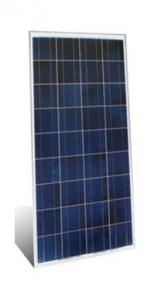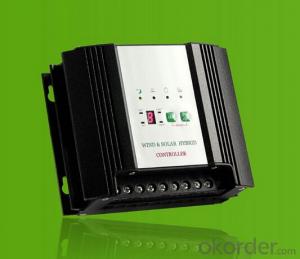Multifunctional 30A 96V Battery MPPT Solar Charge Controller20A~30A
- Loading Port:
- China main port
- Payment Terms:
- TT OR LC
- Min Order Qty:
- 20 unit
- Supply Capability:
- 9999 unit/month
OKorder Service Pledge
OKorder Financial Service
You Might Also Like
96V Auto identification MPPT Solar Charge Regulator 30A with LCD and LED
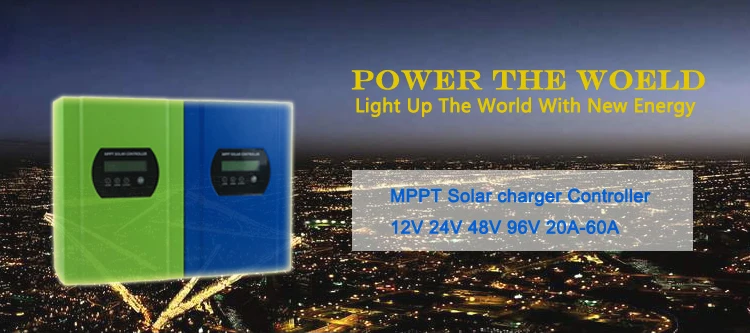
| Introduction |
This is a smart solar charge controller which has advanced MPPT technology .
Solar charge controller is one of the important parts in the off-grid solar system.
For having the advanced MPPT technology, the controller can trace the peak power with 99%
conversion efficiency. MPPT microprocessor, inside the controller,making 30% more charge
current with significantly less power than tradition. In addition to this, easier installing and supporting
to expand volume are other advantages. It can also store energy to different kinds of batteries.
We provide battery choice(Vented,Sealed,Gel,NiCd).
| Product Show |
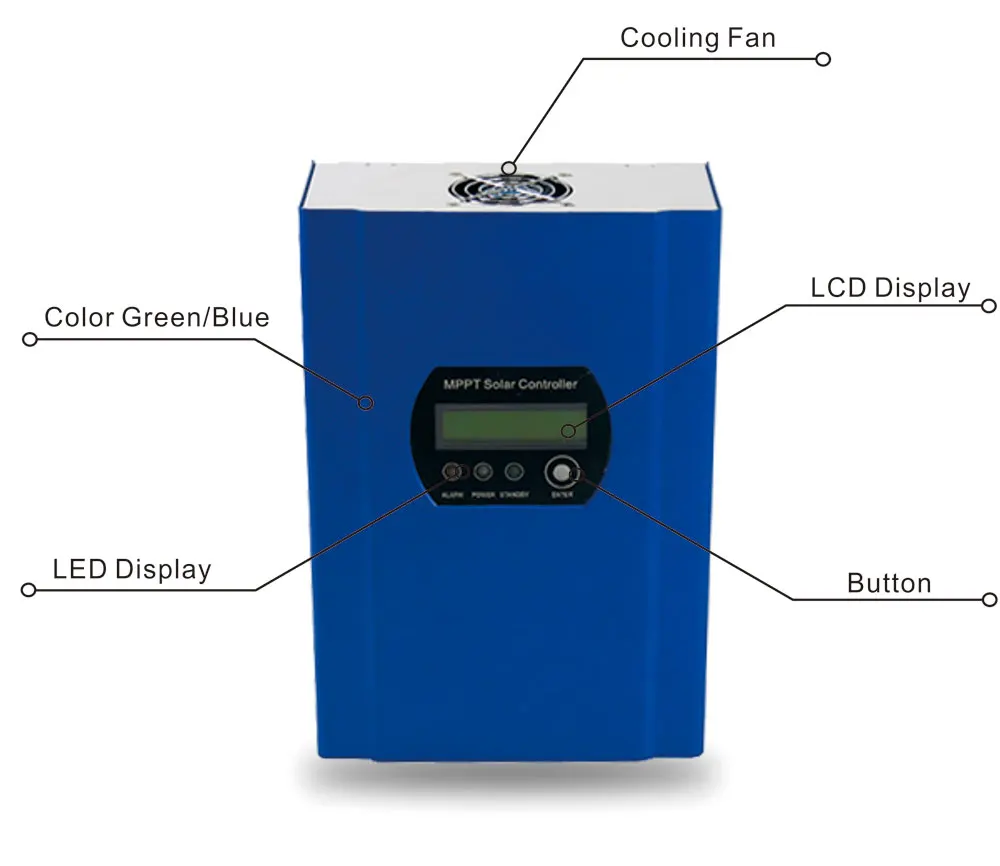
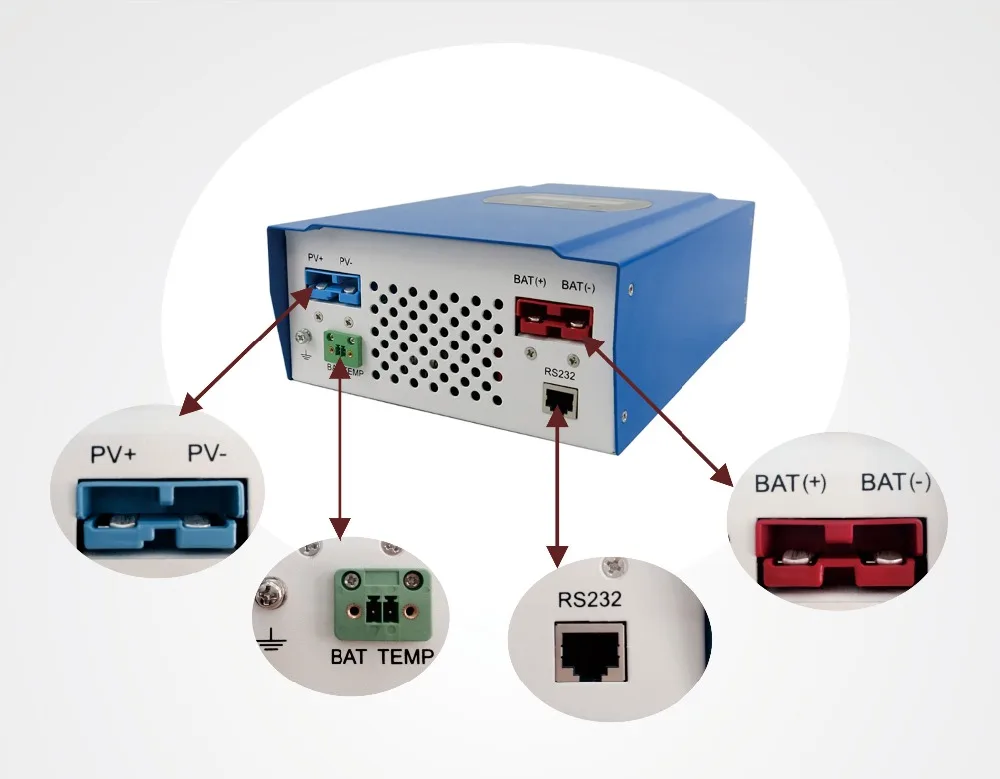
Please check the design brief,technical documents,product manual etc .
| Features |
1. Peak efficiency upto 99% with MPPT,increasing 30%~60% efficiency than traditional controller.
2. 12v/24v/48v system voltage automatic recognize.
3. Maximum input PV voltage upto DC150V.
4. 105degrees can be sufferred by good components.
5. Charge mode: three stages (fast charge, constant charge, floating charge)
6. Support kinds of batteries:Gel,Sealed lead acid,vented,NiCd,etc.
7. LCD and LEDs show parameters and system information,like PV input voltage,battery voltage,charge current,charge power,etc.
8. Port RS232 or connects to PC with upper software to show working state and parameters in 11 languages.
9. CE,RoHS certificatons approved.
10. 2 years warranty;3~10 years extended technical service.
| Application |
Off grid PV system show with our I-P-TPI Pure sine wave inverter:

| Parameter |
Model: I-P-MSC-DC12V/24V/48V/96V-series | 20A | 30A | ||
Charge Mode | Maximum Power Point Tracking | |||
Method | 3 stages: fast charge(MPPT),constant voltage,floating charge | |||
System Type | DC12V/24V/48V/96V | Automatic recognition | ||
System Voltage | 12V system | DC9V~DC15V | ||
24V system | DC18V~DC30V | |||
48Vsystem | DC36V~DC60V | |||
96Vsystem | DC72V~DC120V | |||
Soft Start Time | 12V/24V/48V/96V | ≤10S | ||
Dynamic Response Recovery Time | 12V/24V/48V/96V | 500us | ||
Conversion Efficiency | 12V/24V/48V/96V | ≥96.5%,≤99% | ||
PV Modules Utilization Rate | 12V/24V/48V/96V | ≥99% | ||
Input Characteristics | ||||
MPPT Working Voltage and Range | 12V system | DC18V~DC150V | ||
24V system | DC34~DC150V | |||
48V system | DC65~DC150V | |||
96Vsystem | DC125~DC300V | |||
Low Voltage Input Protection Point | 12V system | DC16V | ||
24V system | DC30V | |||
48V system | DC60V | |||
96Vsystem | DC120V | |||
Low Voltage Input Recovery Point | 12V system | DC22V | ||
24V system | DC34V | |||
48V system | DC65V | |||
96Vsystem | DC125V | |||
Max DC Voltage | 12V/24V/48V system | DC160V | ||
96Vsystem | DC300V | |||
Input Overvoltage Protection Point | 12V/24V/48V system | DC150 | ||
96Vsystem | DC300V | |||
Input Overvoltage Recovery Point | 12V/24V/48V system | DC145V | ||
96Vsystem | DC295V | |||
Max. PV Power | 12V system | 280W | 450W | |
24V system | 560W | 850W | ||
48V system | 1120W | 1700W | ||
96Vsystem | 2240W | 3400W | ||
Output Characteristics | ||||
Selectable Battery Types (Default type is GEL battery) | 12V/24V/48V/96Vsystem | Sealed lead acid, vented, Gel, NiCd battery | ||
Constant Voltage | 12V/24V/48V/96Vsystem | Please check the charge voltage according to the battery type form. | ||
Floating Charge Voltage | 12V/24V/48V/96Vsystem | |||
Over Charge Protection Voltage | 12V system | 14.6V | ||
24V system | 29.2V | |||
48V system | 58.4V | |||
96V system | 116.8V | |||
Rated Output Current | 12V/24V/48V/96Vsystem | 20A | 30A | |
Current-limiting Protection | 12V/24V/48V/96Vsystem | 25A | 35A | |
Temperature Factor | 12V/24V/48V/96Vsystem | ±0.02%/℃ | ||
Temperature Compensation | 12V/24V/48V/96Vsystem | 14.2V-(The highest temperature-25℃)*0.3 | ||
Output Ripples(peak) | 12V/24V/48V/96Vsystem | 200mV | ||
Output Voltage Stability Precision | 12V/24V/48V/96Vsystem | ≤±1.5% | ||
The specification is only for reference. Subject to change without prior notice.
RS232 Function working stat |
The Figures of the PC Firmware and Testing Software:
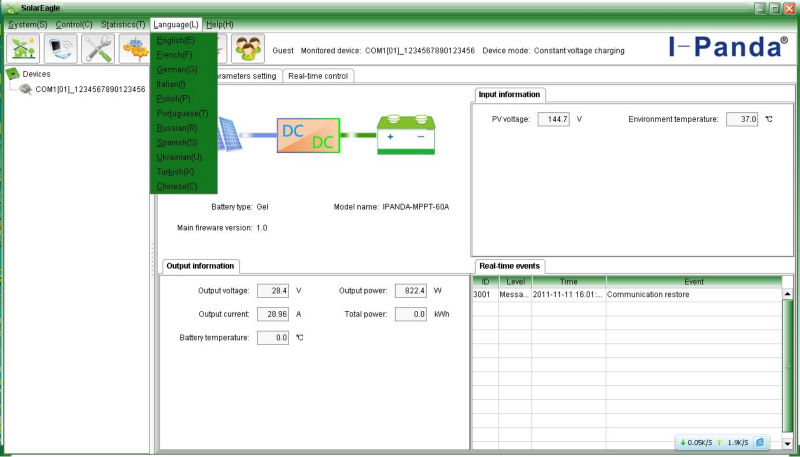

We provide OEM and ODM service.The 36V/72V/96V model also can be custom made for you.
Packaging |
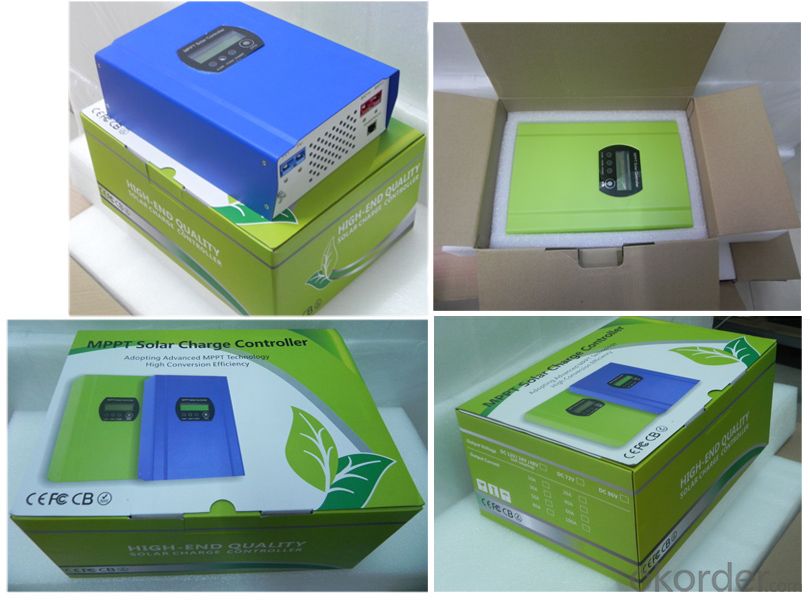
Certifications |
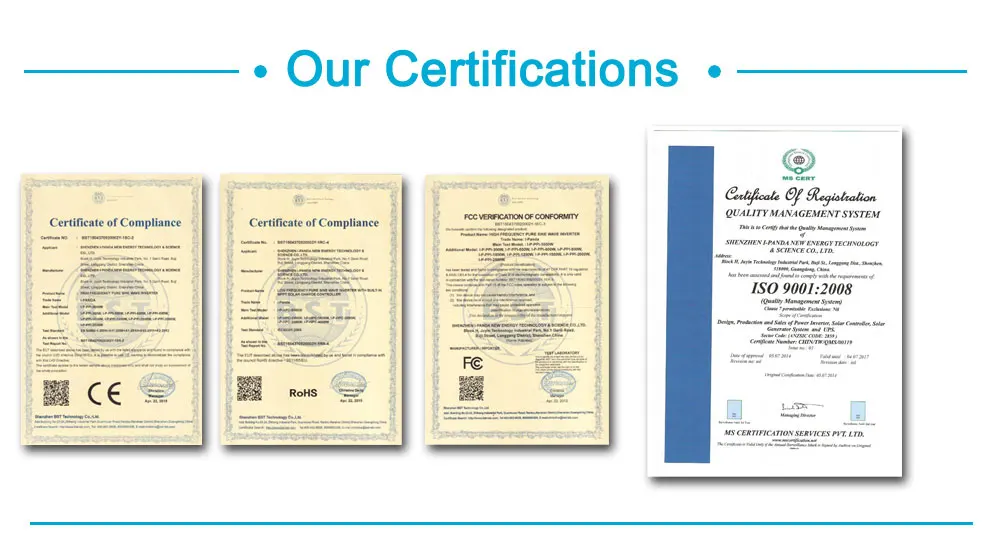
F&Q: |
Q1. How to ensure and monitor the products quality?
A1: We have established a perfect Quality Management System, In strict
accordance with ISO9001: 2008 quality system and ISO14001 environment system for quality assurance management;
Our ISO9001:2008 Quality System certificate encoding: CHIN/TW/QMS/00119;
Our ISO14001 Environment System certificate encoding: CHIN/TW/EMS/00028;
Q2. What is the warranty of products?
A2: The warranty period of different products are different; 5 years, 3 years, 2 years, 1 years; More details please refer to the product specification or manual; we will provide free life-long technical support ;
Q3. What is the difference between MPPT&PWM?
A3. MPPT charging mode, peak efficiency up to 99%, saving 30%~60% solar panel than traditional PWM controller.
- Q:Can a solar controller be used in a mobile solar system (e.g., RV, boat)?
- Yes, a solar controller can be used in a mobile solar system such as an RV or boat. A solar controller helps regulate the charging and discharging of batteries in a solar power system, ensuring optimal performance and protection. Whether it is a fixed or portable solar panel setup, a solar controller is essential for efficient power management and extending battery life.
- Q:Are there any safety features in solar controllers?
- Yes, there are several safety features in solar controllers. One of the main safety features is overcharge protection. Solar controllers are designed to prevent the batteries from overcharging by regulating the amount of current flowing into the batteries. Once the batteries are fully charged, the solar controller will automatically reduce or stop the charging process to prevent damage to the batteries. Another safety feature is over-discharge protection. Solar controllers monitor the voltage of the batteries and prevent them from discharging below a certain threshold. This helps to prolong the lifespan of the batteries and prevents damage that can occur from over-discharging. Short circuit protection is also an important safety feature in solar controllers. In the event of a short circuit, the solar controller will detect the abnormal current flow and automatically shut off the circuit to prevent any damage to the solar panels, batteries, or other connected devices. Additionally, some solar controllers have temperature compensation features. These controllers can adjust the charging voltage and current based on the temperature of the batteries, ensuring optimal charging performance and preventing overheating or damage due to extreme temperature conditions. Overall, solar controllers are equipped with various safety features to protect the batteries, solar panels, and other connected devices from potential hazards and ensure efficient and safe operation of the solar power system.
- Q:How does a solar controller handle the protection against electrical surges?
- A solar controller handles protection against electrical surges by incorporating surge protection devices and transient voltage suppressors. These devices are designed to divert or limit excess voltage and current caused by surges, preventing damage to the controller and connected solar equipment. Additionally, some solar controllers may also feature built-in circuitry that monitors and regulates voltage levels to ensure safe operation and protect against surges.
- Q:How does a solar controller prevent damage to the solar panels from hail or storm events?
- While a solar controller may not directly prevent damage to solar panels caused by hail or storms, it plays a vital role in safeguarding their safety. The primary function of a solar controller is to regulate the charging and discharging of batteries within a solar power system. This means that in the event of a storm or hail, the solar controller can detect any fluctuations in voltage and current generated by the panels. If the voltage or current surpasses a specific threshold, indicating potential damage to the panels, the solar controller can automatically disconnect them from the battery system. By disconnecting the panels from the battery system, the solar controller effectively isolates them from the rest of the system, minimizing the likelihood of damage. This is crucial as hail or storms can cause high voltage surges or irregular power fluctuations, which could potentially harm the panels or other system components. Additionally, the solar controller offers real-time monitoring of the panels' performance and condition. This enables the system owner to stay updated on any damage caused by hail or storms. By being aware of such issues, the system owner can take appropriate measures, such as repairing or replacing damaged panels, to ensure the continuous efficient operation of the solar power system. Although a solar controller cannot completely prevent damage from hail or storms, its ability to disconnect the panels from the system and provide monitoring capabilities significantly reduces the risk of damage, thereby protecting the investment in solar panels.
- Q:Can a solar controller handle power fluctuations from the charge controller?
- Yes, a solar controller is designed to handle power fluctuations from the charge controller. It acts as a regulator to stabilize and control the flow of power coming from the charge controller, ensuring a consistent and reliable energy supply to the connected devices or battery.
- Q:Can a solar controller be used in a solar-powered deep-sea mining system?
- Yes, a solar controller can be used in a solar-powered deep-sea mining system. A solar controller is responsible for regulating and optimizing the charging process of solar panels, ensuring proper power management and protection. In a deep-sea mining system, where sunlight may be limited, a solar controller would be essential to efficiently harness and utilize the available solar energy for powering the system's operations.
- Q:Can a solar controller be used in conjunction with a solar inverter?
- Yes, a solar controller can be used in conjunction with a solar inverter. A solar controller is responsible for regulating and controlling the flow of electricity from solar panels to batteries, while a solar inverter converts the DC (direct current) power generated by the solar panels into AC (alternating current) power that can be used to power appliances and devices. By working together, a solar controller ensures that the batteries are properly charged and protected, while the solar inverter efficiently converts the solar energy into usable electricity.
- Q:How do you prevent overheating of a solar controller?
- There are a few ways to prevent overheating of a solar controller. Firstly, it is important to ensure that the controller is installed in a well-ventilated area, away from direct sunlight or any heat sources. Additionally, using heat sinks or fans can help dissipate excess heat from the controller. Regular maintenance, such as cleaning dust or debris from the controller, can also aid in preventing overheating. Lastly, choosing a solar controller with built-in temperature sensors and automatic shut-off features can provide added protection against overheating.
- Q:Can a solar controller be used with a solar-powered manufacturing plant?
- Yes, a solar controller can be used with a solar-powered manufacturing plant. A solar controller regulates the flow of electricity from the solar panels to the manufacturing plant, ensuring optimal power generation and utilization. It helps manage the charging and discharging of batteries, monitors system performance, and protects the equipment from overcharging or excessive discharge. By effectively controlling and optimizing the solar power system, a solar controller enhances the efficiency and reliability of a solar-powered manufacturing plant.
- Q:What is the equalization charging mode of a solar controller?
- The equalization charging mode of a solar controller is a process where the controller intentionally overcharges the batteries to balance the voltage levels of individual battery cells. This helps to prevent stratification, a condition where certain cells in the battery pack have a higher voltage than others, which can lead to reduced battery capacity and lifespan. By equalizing the charge across all cells, the controller ensures optimal performance and longevity of the batteries.
1. Manufacturer Overview |
|
|---|---|
| Location | |
| Year Established | |
| Annual Output Value | |
| Main Markets | |
| Company Certifications | |
2. Manufacturer Certificates |
|
|---|---|
| a) Certification Name | |
| Range | |
| Reference | |
| Validity Period | |
3. Manufacturer Capability |
|
|---|---|
| a)Trade Capacity | |
| Nearest Port | |
| Export Percentage | |
| No.of Employees in Trade Department | |
| Language Spoken: | |
| b)Factory Information | |
| Factory Size: | |
| No. of Production Lines | |
| Contract Manufacturing | |
| Product Price Range | |
Send your message to us
Multifunctional 30A 96V Battery MPPT Solar Charge Controller20A~30A
- Loading Port:
- China main port
- Payment Terms:
- TT OR LC
- Min Order Qty:
- 20 unit
- Supply Capability:
- 9999 unit/month
OKorder Service Pledge
OKorder Financial Service
Similar products
New products
Hot products
Hot Searches
Related keywords





